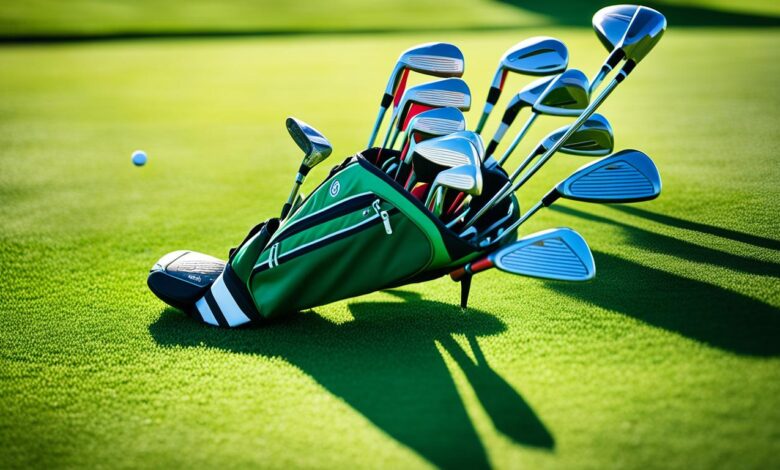Swing into Action: Key Golf Basics for New Players

Starting golf is exciting yet it can feel overwhelming at first. Thanks to Zach, a former competitive college golfer, you’re in good hands. He shares his wisdom with over a million golfers on The DIY Golfer. This guide covers everything new players need to know to get started.
It sets realistic expectations from early learning to being a skilled player. Zach talks about the right golf gear too. This includes clubs, balls, shoes, and more. Plus, he gives beginner-friendly recommendations.1
This guide is all about mastering the basics. You’ll learn about grip, stance, ball flight, and club distances. These are the first steps to a great golf swing and hitting the ball well.2
It also covers short game skills like chipping and putting. And it’s important to know the rules and etiquette. By practicing these, new golfers will have more fun and less frustration on the course.2
The article reminds us that practice makes perfect. It highlights the value of getting lessons and joining a golf club. With dedication, you can turn from a new golfer to a rewarding golf player.
So, get ready to start your golf journey. Following the tips in this article will help you learn the basics. You’ll also find a love for the game that lasts a lifetime.
Setting Realistic Expectations
Golf can feel daunting, especially for new players. They often wonder about the right gear, rules, and skills. This article aims to help by giving a realistic path for new golfers who can practice and play 1-3 times a week.3
Timeline for Progress as a New Golfer
Within the first 3 months, expect to miss the ball often and lose a few. It will be hard to hit shots consistently, but the thrill of a nice shot keeps you going.3
From month 3 to 12, shots improve in accuracy at the range. You’ll finish rounds requiring fewer ball pickups.3
Months 1-3: Visiting the Range and Golf Store
Early on, expect to miss the ball and lose some. But, those great shots are the real motivators. They make sure you stick with golf.3
Months 3-12: Hitting More Consistent Shots
Continuing to practice will show improvements. You’ll hit more squarely at the range and finish courses more smoothly. Picking up your ball won’t be as common.3
Year 2: Golf Starts Getting Really Fun
By year two, the game really picks up. You can complete full rounds and maybe even rival the more experienced golfers.3
Years 3+: Becoming a True Golfer
After about three years, you’ll have a chance to play on nicer courses. Upgrading your gear is part of the fun. And you’ll feel like a pro, a real “true golfer.”3
Remember, setting real goals is key. Don’t give up, as growing in golf takes time and plenty of practice.3
Beginner Golf Equipment
It’s easy to lose a lot of money on2 golf gear. But new golfers can start just fine without splurging on costly items.2
Purchasing on Amazon vs. In-Store
Buying a beginner set on Amazon is seen as a smart move. It’s convenient and offers a good foundation. This set can be upgraded within a couple of years as your game improves.
Best Golf Sets for Beginners
Looking at beginner sets, the author suggests 9-, 10-, or 12-piece sets. These sets have all the must-have clubs for starters. No need for a full 14-piece right away.4
Recommended Golf Balls, Shoes, and GPS
Besides the set, essential items include golf balls, shoes, a GPS tool, and accessories. Don’t forget things like tees, a towel, and a divot repair tool.2
For balls, consider the Wilson Profile Distance. They’re great for beginners, often losing balls during the learning process.2
When it comes to shoes, try the FootJoy Flex or Fuel models. They offer great traction and support without being too aggressive with spikes.2
Using a GPS tool or rangefinder to find distances is a game-changer. It helps in picking the right club and managing the course better.2
Essential Golf Accessories
The last thing to cover is essential accessories. This includes tees, a groove cleaner, and a ball marker with a divot repair tool. These items are key for keeping the course in good shape and playing with the right manners.2
Learning the Fundamentals
The secret to golf success is to master basic skills in the right order.5 New golfers should learn these key skills to build a strong golf swing.5
Proper Golf Grip
The first thing to tackle is the proper golf grip. This is your main link to the club.6 You have three choices: baseball, overlap, or interlock. The writer suggests using a grip trainer to nail the right grip.6
Stance and Posture
Then, work on your stance and posture. This means bending at the hips, getting your weight right, and aligning your feet and body properly.6 They also give tips on hand positions for various grips if you’re a righty or lefty.6
Understanding Ball Flight
To wrap up, it’s vital to grasp how ball flight works. And how to hit the ground right so the ball goes up.6 Don’t shy away from hitting the ground in practice if it helps you feel the right way.
These basics form the foundation of a strong, repeatable golf swing. Newcomers must focus on mastering these essentials before advanced skills.5 Just hitting balls at the range won’t cut it for real progress. Use daily practice and professional advice to get it right and avoid bad habits.5
Knowing Your Distances
Starting out in golf, it’s vital to know how far your clubs can hit the ball.2 The GolfLogix app, recommended by GOLF.com, is great for keeping tabs on your distances.2 This skill will make choosing the right club easier, boosting your game on the course.2
You can figure out your distances using a golf app, GPS, or just by walking off the yardage.2 It’s key to track how far each club goes. These numbers will guide your shot planning as you get better.2
Learning your club distances will boost your confidence. You’ll be able to play smarter and have more fun out there.2
Reliable Fairway Club
For newbie golfers, picking a reliable fairway club is tough. They often prefer a hybrid to a fairway wood. A lofted fairway wood, like a 7-wood, is a top choice for them.2 It balances distance and accuracy better than lower-lofted woods. This helps in gaining confidence and consistent shots around the field.
Finding a reliable fairway club to hit well makes the game more enjoyable. Stick to a club that feels right and gives good distance. It’s crucial for improving your golf game over time.2
Basic Golf Chip
For beginner golfers, learning a basic golf chip shot is key. It’s vital for success on the course.7 In a typical 18-hole game, players make about 36 to 40 chip shots. That’s almost a quarter of their total score.7 Chipping makes up around 25% of all shots in golf. So, having a reliable chip near the green is important.
The author shares an easy method for the chip shot. Hold the club lower, stand narrow, lean towards the target, and use a motion like putting to hit the ball.2 Using a pitching wedge is suggested. It’s important to practice to control the distance well.7
The right club for chipping is critical. Different clubs work best for various conditions. They depend on loft, bounce, and the area where you play.
Putting comes first when it comes to the short game. This is followed by chipping, then pitching, if needed.2 Managing the short game well helps new players lower their scores and avoid risks.
Distance control is a must in chipping. The height and how far the ball goes depend on its loft. Good technique, including grip and body position, helps achieve this.7 Getting distance control right in chip shots is like hitting the perfect high note in music. It can greatly affect your golf performance.
Getting good at the basic chip shot can reduce your scores. It’s crucial for new players. It helps keep the ball in play and avoid large score increases.

Short Game Priority Order
The “short game priority order” is key for new golfers, the writer says.2 The focus is on doing the smallest moves for the least chance of mistakes. So, the order is: 1) Putt first, 2) Chip if putting is not possible, and 3) Pitch (a longer, higher shot) as a last resort.2
Choosing in this order helps players stay in bounds and avoid high scores, even if they don’t hit the green.2 It’s a basic but vital technique for new golfers. It teaches them to take less risk and be more reliable as they grow their game.2
By going for the easiest and safest shots first, players get more sure of themselves. They also avoid the stress of challenging shots.2
Swing into Action: Key Golf Basics for New Players
As a new player, learning the basics is key to a strong golf game.3 The DIY Golfer platform helps over 1 million new golfers a year. Zach, a pro, shares how to start in golf.
Getting your ball in the air is tough for newbies, but essential.8 You need the right grip, stance, and swing. These make sure you hit the ball well every time.
Knowing how far your clubs can hit is a must for better games.3 Start with 10-12 clubs, then get a full set of 14 as you get better. This knowledge helps you pick the right club for each shot.
Choose a good club for fairway shots, like a fairway wood or hybrid, to feel more in control.2 Learn which short game shots are key – putt, chip, pitch. This helps you stay safe and get better.
Bunker shots can be tricky. Focus on hitting the sand under the ball to pop it out.2 Always have the right gear and accessories in your bag before you play.
How you putt is vital. Adjust your backstroke for better control. Smaller strokes mean slow swings, bigger ones make faster swings.2 Learn basic rules and manners in golf. This includes fixing the course and knowing where you can play from.
Bunker Shots
Many golfers get nervous about bunker shots, but they can be handled well with the right approach.9 The old wisdom of shifting your stance or swinging differently in bunkers doesn’t hold up anymore.9 For a good setup in bunkers, keep your feet straight toward your target, put the ball more towards the front, and open up the clubface.9 It’s key to not tilt the wedge too much forward in bunkers to avoid bad hits.9 Also, putting your weight on your front foot can improve your shot.9
Committing to Hitting the Sand
Sand shots are tough, especially for new golfers. The writer points out it’s better to aim to hit the sand first, not the ball directly out, which is a mistake many make.10 He suggests planting your feet solidly in the sand and moving the ball a bit forward in your stance.10
Proper Stance and Ball Position
Being in the right position and knowing where the ball should be are vital for success in bunkers.10 The writer believes that with practice and good advice, new players can feel sure about their bunker shots.9 This ability is key to avoiding big trouble with bunkers around the course.9
Essential Gear
Having the right3 golf gear and accessories is key. A good supply of golf balls is crucial because new players often lose many.3 The author also advises including a golf glove (if needed) and enough tees for all your shots.
Golf Balls, Gloves, and Tees
The author also talks about the importance of a ball marker and a divot repair tool.3 These tools help golfers mark their balls and fix any damage to the course. They’re essential for playing right and keeping the course in good shape.
Ball Markers and Divot Tools
A well-prepared golf bag is a must for beginner golfers. It should have plenty of golf balls, gloves, tees, ball markers, and divot tools.3 This makes sure you’re equipped to honor etiquette and care for the course.

Distance Control in Putting
Putting is tough but very rewarding for new golfers. It’s key to stand the right way, look over the ball with your eyes, and let your arms hang below your shoulders.11
Proper Putting Posture
It’s vital to have the right posture for accurate putting. Stand balanced and keep your eyes right on the ball. This helps control where the putt goes and how fast it moves.11
Stroke Length and Distance
For good distance control, learn how the length of your putt affects how far the ball goes. A small stroke means the ball doesn’t go as far. A big stroke sends the ball farther.11 Understanding this link is key for good putting.
Using Your Feet for Stroke Size
Try using your feet to judge the right length of your putting stroke. For short putts, your stroke should go from one big toe to the other. On longer putts, the stroke might be as wide as “six to seven inches past your feet.”11 This tip helps new golfers get a better sense of how much power to use.
Getting putting’s distance control right is vital for handling the course well. It cuts down on three-putt mistakes that hurt a beginner’s score. Paying attention to how you stand, the length of your stroke, and using your feet as a guide, boosts your putting confidence and skill.11
Rules and Etiquette
New golfers should learn the game’s rules and manners. These are as important as getting better at golf. The writer says golfers must respect the course, their opponents, and the sport’s integrity.
Repairing Divots and Ball Marks
Knowing how to fix divots and ball marks is part of golf etiquette.12 Fixing ball marks shows you care about the course. This keeps it in good shape for everyone.13 Golfers should fix any marks on the green. They make the area smoother for putting.
Basic Rules for Drop, Relief, and Hazards
The author explains key rules for newbies. This includes dropping a ball, getting relief, and handling hazards.13 If a ball is lost, find it within three minutes. If not, add a penalty.13 Out of bounds means a “stroke and distance” penalty.
Learning and following these rules and etiquette keeps the game fun and fair.12 It shows respect for the course, other players, and the sport.
FAQ
What is the typical timeline for progress as a new golfer?
What essential golf equipment do beginners need to get started?
What are the key golf fundamentals that beginners should focus on mastering?
Why is it important for beginners to know their club distances?
What is the “short game priority order” that beginners should follow?
What is the proper technique for executing a basic golf chip shot?
What are the key tips for executing successful bunker shots as a beginner golfer?
What are the essential golf accessories beginners should have in their bag?
How can beginners develop better distance control in putting?
What are some of the basic rules and etiquette beginners should be aware of?
Source Links
- https://www.golfdigest.com/story/the-complete-beginner-s-guide-to-golf
- https://golf.com/instruction/golf-basics-every-beginner-golfer-should-know/
- https://www.thediygolfer.com/blog/golf-for-beginners
- https://schiavettagolf.com/uncategorized/what-clubs-you-need-beginner-vs-advanced-golfer/
- https://free-online-golf-tips.com/fundamental-golf-tips/
- https://swingtrainer.com/blogs/instruction/golf-swing-basics
- https://skillest.com/blog/mastering-the-fundamentals-of-golf-chipping/
- https://nationalgcla.com/how-to-hit-a-golf-ball-for-beginners/
- https://practical-golf.com/bunker-shots
- https://www.golfsidekick.com/knowledge/how-to-play-bunker-shots/
- https://www.wgt.com/forums/p/559/890525.aspx
- https://www.golfzonleadbetter.com/blogs/golf-etiquette/
- https://www.pga.com/story/golf-for-beginners-golf-etiquette-rules-and-glossary

